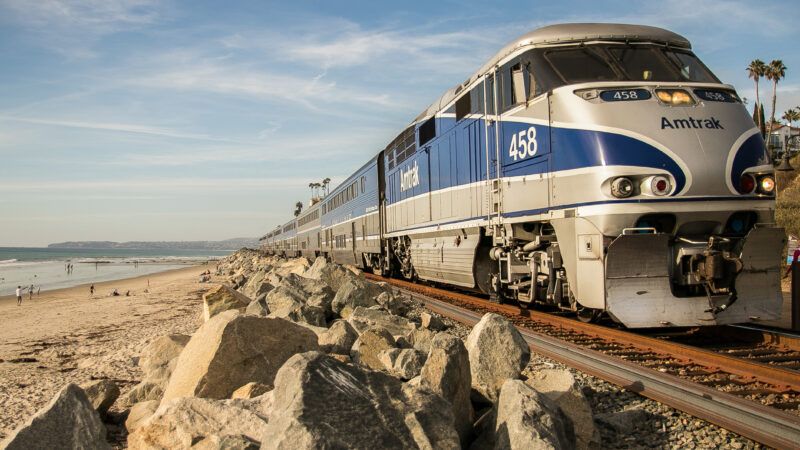Senate Republicans and Democrats Agree To Double Amtrak's Funding
A bill approved by the Senate’s Committee on Commerce, Science, and Transportation would give the money-losing rail company $19 billion over 5 years.

If a bill has the support of both Republicans and Democrats, be concerned. That's certainly the case with a bipartisan transportation bill moving through the Senate that would double the federal subsidies given to Amtrak.
Last week, the U.S. Senate's Committee on Commerce, Science, and Transportation voted 25 to 3 to advance a $78 billion surface transportation bill that gives the government-owned passenger rail service $19 billion over five years, for an average of $3.8 billion per year.
Of that, $6.5 billion would go to the higher-ridership Northeast Corridor that runs from Washington, D.C., up to Boston. The other $12.5 billion in funding would go to Amtrak's network of routes that run across the rest of the country.
This funding is notably less than a few other transportation proposals currently on the table. Amtrak itself has put out a "corridor vision" that calls for $75 billion in funding over the next 15 years (or $25 billion over the next five).
That's less than what some House Democrats want to shower on the company. Earlier this month, the House Transportation and Infrastructure Committee passed a surface transportation bill that included $32 billion over five years for Amtrak—triple its current funding.
President Joe Biden's American Jobs Plan, meanwhile, would devote $80 billion over eight years to the company, or $50 billion over the next five.
All of these proposals would boost Amtrak's funding above the emergency levels it received during the pandemic. Plummeting ridership prompted Congress to include an additional $1 billion for Amtrak in the CARES Act passed in March 2020. The American Rescue Plan, passed in March 2021, gave it another $1.69 billion.
The fact that members of both parties were able to agree on these massive spending increases is evidence that the system still works, according to Sen. Roger Wicker (R–Miss.), the committee's top Republican.
"It is essential that we work to find common ground to make sure our extensive rail network keeps pace with a growing economy, that trucks are able to get goods to port and that rural and disadvantaged communities are given adequate resources," he told the Washington Post.
Wicker has been a major proponent of expanding Amtrak service in his own state. He's pushed for a return of Amtrak passenger rail service along the Gulf Coast between Mobile, Alabama, and New Orleans, Louisiana, which was discontinued after Hurricane Katrina.
Amtrak's own $75 billion "corridor vision" also calls for creating new 39 new routes, and providing service to 160 new cities.
The problem, says Marc Scribner, a transportation researcher with the Reason Foundation (which publishes this website), is that the vast majority of the new routes Amtrak wants to create would run along privately owned freight railroad tracks.
"When Amtrak is talking about expanding service, they're not talking about building parallel track," he told Reason in May. "Whenever we're talking about Amtrak service expansion, the other side of that is freight rail service degradation."
In the Gulf Coast example, CSX Transportation, Inc. and Norfolk Southern Corporation—which own the tracks on which Amtrak's Gulf Coast service would run—have opposed the company's plans for renewed passenger service, in part because of the potential disruption it would cause to freight service.
Over 70 percent of the miles Amtrak trains travel are over privately owned freight railroads.
Amtrak does own the vast majority of the track it uses in the Northeast Corridor, allowing it to run more frequent train service without displacing freight rail traffic. That's a mixed blessing, however, as Amtrak's ownership of these tracks also means it's on the hook for a maintenance backlog of between $31 billion and $42 billion that its own revenues come nowhere near covering.
An influx of additional funding would allow Amtrak to eliminate this backlog and pave the way for faster, more frequent service, passenger rail proponents argue. "There's so much we can do, and it's the biggest bang for the buck we can expend," said Biden about increasing Amtrak funding back in April.
Nevertheless, one of the reasons that Amtrak's maintenance backlog is so big in dollar terms is that it's incredibly inefficient at spending the money it does get.
At current costs, Amtrak needs to spend $90 million per mile "merely to keep the same service as exists today," wrote the Manhattan Institute's Connor Harris in an April New York Post column. "For comparison, in countries such as France and Spain, less than half that cost per mile would cover a brand-new high-speed rail line good for speeds of more than 200 miles per hour."
Getting Amtrak's costs down to European levels would allow it to fix a lot more of its infrastructure for a lot less money. Lawmakers of both parties instead appear set on simply shoveling more taxpayer money at the inefficient agency.
